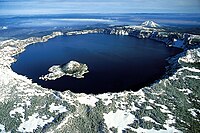
Photo from wikipedia
Abstract The Planchon-Peteroa Volcanic Complex (PPVC) is located in the Central Andes, Argentina-Chile. Even though this active volcanic system is considered one of the most dangerous volcanoes in the region,… Click to show full abstract
Abstract The Planchon-Peteroa Volcanic Complex (PPVC) is located in the Central Andes, Argentina-Chile. Even though this active volcanic system is considered one of the most dangerous volcanoes in the region, with more than twenty modest (VEI Seismic interferometry (SI) is a high-resolution technique based on analyses of the interference of the propagation seismic energy at one or many stations. SI can be used to characterize the subsurface properties of a target area. In particular, previous SI studies performed in the area of the PPVC describe specific ranges of depth; therefore, more information is required for a thorough description of the subsurface features in the area and for a better understanding of the PPVC dynamics. We apply SI based on autocorrelations of selected regional and teleseismic events to image the subsurface structures below stations located in Argentina and Chile during 2012. The selection of the events is performed according to their location, magnitude, angle of incidence of P-wave seismic energy, and signal-to-noise ratio in the records. For each station, we extract time windows and we process them using two ranges of frequency, which are sensitive to different depth ranges. This work describes depths and zones previously not analyzed in the area using SI methods. The results not only complement the available geological, geochemical, and geophysical information, but present new information for depths between 10 and ~750 km depth, increasing the general knowledge of the subsurface features in the PPVC. Finally, we also propose a model for the subsurface down to the Moho, which indicates the crustal structure and the likely distribution of magma bodies in depth.
Journal Title: Journal of Volcanology and Geothermal Research
Year Published: 2020
Link to full text (if available)
Share on Social Media: Sign Up to like & get
recommendations!